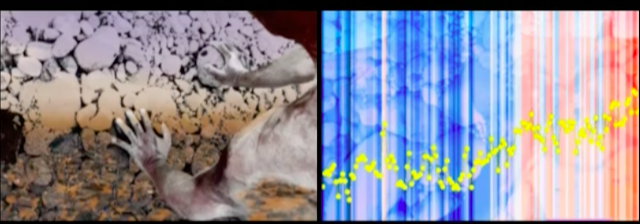Dry Days, composed by Aron Faria, and being performed live by Paul Godwin, Miguel Noya, Dustin Koupal and Aron Faria on April 23rd, 2022, as part of the event, Earth Dayta, is inspired by data that shows the average yearly temperature slowly
increasing through the year 2099.
The
foundation of the piece uses two identical musical loops playing
simultaneously, with one slowly increasing in tempo to represent the increasing
temperature. The simultaneous video sequences similarly shift in tempo and
duration, allowing new imagery to appear. The piece shows how change is not
always noticeable right away, but over time one can see the effects and feel the impact of small changes on larger systems.
Dry Days also makes visual use of popular climate change graphics that have been shared with the public over the last several year, known as the warming stripes. Warming stripes (sometimes referred to as climate stripes or climate timelines) are data
visualization graphics that use a series of colored stripes
chronologically ordered to visually portray long-term temperature trends. The warming stripes were created by Professor Ed Hawkins
at the University of Reading in 2018. These graphics show clearly and vividly how
global average temperatures have risen over the past 150 years. They are designed to prompt more inquiry and conversation about climate change.
Harbingers are subtle indicators of change in the climate. Harbingers can be extremely local, or global.
Video stills by Ameera Godwin, from Harbingers
Dry Days shares the common intention of all three movements of the media and music piece, Harbingers, and that is to apply scientific data to music and video in ways that make use of logic and math modeling--and, that also offer a lot of leeway for building our own visceral interpretations and emotional mappings to the data.
We are acting as both scientists and artists as we create this piece to provoke closer connections to the local environment and to the planet.
by Ameera Godwin, Video Artist/Artistic Director, Myrtle Tree Arts for Earth Dayta
#ShowYourStripes #EarthDay #EarthDayta @myrtletreearts @ameeravideo57 @arconservancy
Harbingers will be performed at the event, Earth Dayta. Please see information and links below.
Web site: https://www.arconservancy.org/event/special-event-earth-dayta/


Comments
Post a Comment